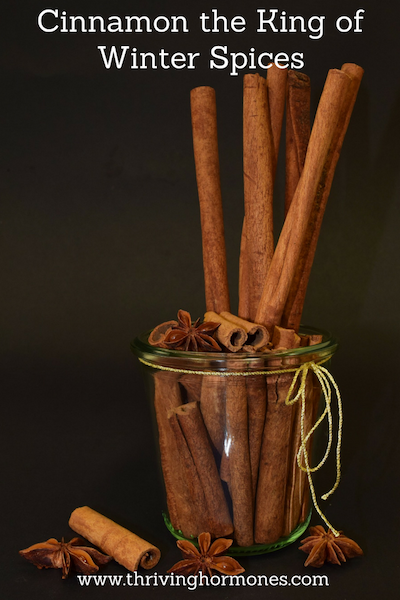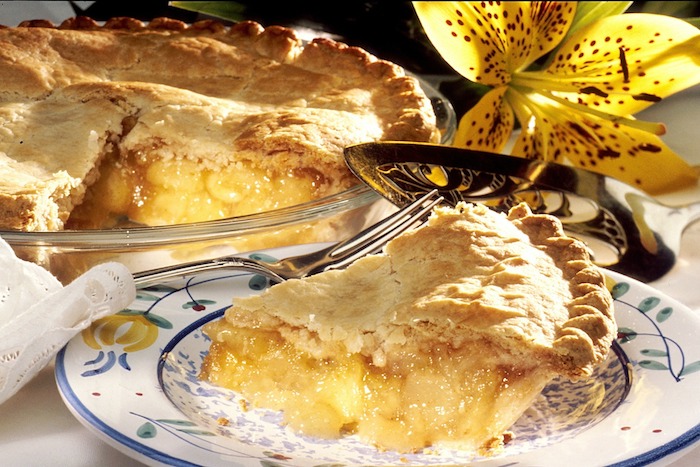Cinnamon the King of Winter Spices.
Do you know that cinnamon can help get rid of a common cold, can be used as a blood thinner, can help balance your blood sugar and it can be used as a fungicide?
It also helps with hormones balance, and I will explain it in a bit.
Cinnamon is the most loved spice in the world and it is one of my favorite spices to use especially in winter. It has been used for holiday cooking for centuries. It is added to apple pies, apple crisp, pumpkin pies, strudels, mulled cider and more. The sweet, bitter, spicy and pungent flavor makes a cinnamon perfect complement to winter foods such as baking, curries, moles, stews, casseroles and hot beverages. It can also be added to yogurts, smoothies, fruits, granolas, and black beans.
I always ground my spices fresh! It is the best flavor you can get! I have a designated coffee grinder for my spices, and I only ground small quantities. Freshly ground cinnamon smell and taste amazing! Ground cinnamon is best suited for quick cooking foods, or you can add on the end of cooking to add a better flavor. It has a bolder flavor and releases flavor more quickly. Whole cinnamon can be used in longer cooking dishes like stews, curries, spiced wines, ciders, etc. Whole cinnamon gives a more subtle flavor.
Interesting fact: fat helps activate cinnamon’s flavor and it helps to keep the flavor for a longer time. So use any fat, like coconut oil, avocado oil, ghee, butter when you cook with cinnamon. The fat is also used in the Indian technique called tarka. The whole Cinnamon is fried in oil or clarified butter to impart flavor to the fat before cooking with it.
Cinnamon comes from the bark of the tree native to Ceylon (Sri Lanka), and it also comes from other species like Cinnamomum like camphor and cassia. The oil from the tree bark contains the active ingredient, cinnamaldehyde, which gives cinnamon its flavor and aroma. Cinnamon gives you a feeling of warmth and comfort.
How to know the difference between Ceylon and Cassia cinnamon?
Ceylon Cinnamon:
– Color: tan brown
– Easily broken and fragile
– Sweet and delicate sent with some clove notes
– Much more expensive
– Paper-like thin with multiple layers when rolled up
Cassia cinnamon:
– Color: Reddish, dark brown
– Super tough very difficult to grid it to a powder
– Full-bodied pungent taste
– Easily available and inexpensive
– Think bark with few layers when rolled up
How to store it?
It is best freshly ground!
Store it in a glass container in a cool dark place.
It will last for about six months, but it is not going to have such a distinctive flavor. Cinnamon sticks can last one year.
To extend the shelf life toy can store it in the refrigerator.
Help benefits of cinnamon:
Cinnamon is a dry spice, and it is perfect for the cold and moist climate. It helps arthritis and muscle cramping that usually gets worst during rainy and cold weather.
Cinnamon oil calms the nervous system.
Cinnamon oil is also used as antifungal and to treat trash and yeast infections. Cinnamon is also helpful in treating Helicobacter pylori bacterial infections, which can cause ulcers.
Studies have shown that cinnamon helps lower blood lipids, triglycerides, and cholesterol.
Cinnamon can be used as a gargle to treat sore throats.
Cinnamon is carminative ( gas-reliever), antifungal, antibacterial, an astringent (tissue-tightener) and analgesic (pain-reliever) and it helps balance blood sugar because it is a circulatory stimulant. Have you ever wonder why do we add cinnamon to the desserts? Cinnamon is added to sweets to balance the effect of sugar! My favorite thing when I lived in Poland was excellent sourdough toast with honey and cinnamon! Yummy!
In traditional Chinese medicine, cinnamon has been used for over five thousand years to cure colds.
Can cinnamon help balance your hormones?
Cinnamon has been used for years to help with heavy menstrual bleeding (menorrhagia), including heavy bleeding due to uterine fibroids and endometriosis. It has been used to help women with insulin resistance associated with PCOS (polycystic ovarian syndrome) and people with type 2 diabetes.
Cinnamon can be used to help with PCOS
Insulin resistance is a massive problem with women with PCOS and that resistance raises the body’s insulin levels. Studies have shown that using cinnamon therapeutically can help reduce insulin resistance in women with PCOS. Cinnamon increase phosphatidylinositol 3-kinase activity in the insulin-signaling pathway. What this process does it boosts the action of the insulin. Phosphatidylinositol 3-kinase, which are a family of enzymes involved in cell function. Cinnamon also improves glucose levels in type 2 diabetes patients. In the studies, people with PCOS and diabetics took cinnamon on an everyday basis, and they had significantly reduced glucose. Some studies have found that cinnamon can help reduce insulin resistance. Cinnamon helps slow the movement of food from the stomach to the small intestine. This process slows the breakdown of carbohydrates, which is vital for people with diabetes and women with PCOS.
Cinnamon is used to lowering sugar cravings, and because of that, it is also helpful in weight loss. Why is so important to keep insulin levels stable for women with PCOS? Because insulin resistance prevents the body from ovulating and it can limit the maturation process of the released egg. Women who are insulin resistant are prone to miscarriage
Cinnamon eases menstrual cramps and bleeding
This herb has been used as a blood thinning agent, and it should not be used other blood thinning medications. It has been found to inhibit thromboxane A2, a substance in the blood, which promotes clotting. By inhibiting thromboxane A2 substance there is less clotting, and this process will encourage healthier flow, which can be very helpful for women who suffer from heavy menstrual bleeding caused by uterine fibroids, menorrhagia or endometriosis.
For heavy bleeding make a tea from cinnamon bark and red raspberry. It will help you reduce the pain and heavy flow. Put four cinnamon barks in a saucepan with 1 liter of water and cook it for 20 min on low heat. Then add 1/8 C raspberry leaves. Let it steep for 20 min.
Cinnamon can help women with endometriosis (when the tissue in the inner layer of the uterine wall grows outside of the uterus, like on the ovaries, colon, fallopian tubes, vagina). Endometriosis is painful, and women experience excessive bleeding.
Uterine fibroids can cause excessive bleeding also.
Women also suffer form Menorrhagia, which is heavy or irregular menstrual flow. This condition is caused by endometriosis, fibroids and other hormonal imbalances. Women with this condition have ovulatory dysfunction, which means that they are not ovulating correctly. Traditionally in Chinese Medicine cinnamon was used to bring warmth to a cold uterus. They thought that cold uterus was congested and they needed to increase circulation, which potential can help reduce menstrual cramping. Cinnamon served as a uterine tonic, and it affects uterine muscle fibers. This action causes mild uterine contraction, therefore, supports bleeding. Studies have shown that lack of uterine tone, rather than the consistency of one’s blood, can lead to menorrhagia.
Cautions: When NOT to use Cinnamon
-Cinnamon can be a blood thinner; those on blood thinning medications do best not use it.
– Cassia cinnamon contains high amounts of coumarin. Large quantities of coumarin could be harmful and can lead to nausea, lost appetite, blurred vision, loss of appetite, diarrhea or liver damage.
You’re better off using Ceylon cinnamon. This type of cinnamon contains lower coumarin content.
– Do not use when you have ulcers.
– Do not use during pregnancy and lactation.
– Don’t take high doses for a long term. Work with a qualified natural health care practitioner and be sure your doctor knows you are using it.
Apple pie
Filling:
2 C coconut sugar
2 T cinnamon
1 tsp nutmeg
5-6 Cortland, McIntosh apples
2 T lemon juice
2 T arrowroot
2 T unsalted butter cut into bits
Coconut milk as needed
Mix sugar, spices, and salt in the bowl.
Peel and core the apples and cut them in thick slices, toss apples in lemon juice and arrowroot. Mix with the sugar and spices.
Transfer the mixture to the crust and dot with butter. Cover with the top crust and refrigerate before you put in the oven, brush with milk. Make holes with a fork so the steam can come out. Bake at 450 for 10 min then reduce the heat 350 and bake for 40-50 min.
Crust: double it!
1 1/8 C gluten free all purpose flour plus some for dusting
½ tsp salt
1 T coconut sugar
8 T 1 stick unsalted butter cut into 8 pieces
3 T ice water
1 yolk
Mix flour, salt, and sugar in the food processor add butter and place it in the bowl. Sprinkle with water, add yolk, and mix it. When the crust is ready to wrap in plastic and put in the freezer for 10 min- helps with rolling.
In Health
Angie
If you are suffering form Hormonal Imbalance my Restore your gut program will help you to balance your hormone. Click on the image!
Refrences:
Wang, J. G., Anderson, R. A., Graham, G. M., Chu, M. C., Sauer, M. V., Guarnaccia, M. M., & Lobo, R. A. (2007). The effect of cinnamon extract on insulin resistance parameters in polycystic ovary syndrome: a pilot study. Fertility and Sterility, 88(1), 240-243. from http://www.fertstert.org/article/S0015-0282%2806%2904555-9
http://science.naturalnews.com
https://pubchem.ncbi.nlm.nih.gov/compound/cinnamaldehyde
http://www.mayoclinic.com
Hlebowicz, J., Darwiche, G., Björgell, O., & Almér, L. O. (2007). Effect of cinnamon on postprandial blood glucose, gastric emptying, and satiety in healthy subjects. The American journal of clinical nutrition, 85(6), 1552-1556. From http://ajcn.nutrition.org/content/85/6/1552.short
Mang B, Wolters M, Schmitt B, Kelb K, Lichtinghagen R, Stichtenoth DO, Hahn A. Effects
of a cinnamon extract on plasma glucose, HbA, and serum lipids in diabetes mellitus type
http://www.nlm.nih.gov
http://cms.bsu.edu
Botanical Medicine for Women’s Health, Aviva Romm, Churchill Livingstone, 2010
Down There Sexual and Reproductive Health, Susun S. Weed, Ash Tree Publishing, 2011




